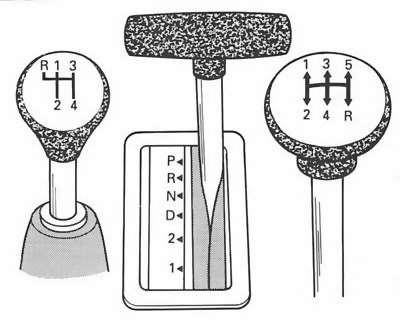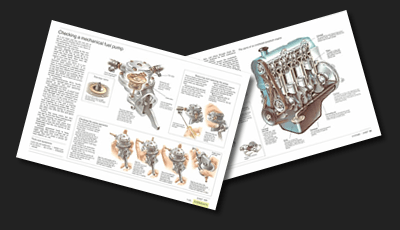Skilled drivers know how to get the most from their cars when circumstances demand it, and an essential part of this ability is knowing how to make the best use of your car's gearbox. It is not enough to know how quickly your car accelerates when you press the pedal; you must also know what to expect in each gear and understand fully the proper use of the gearbox. Most cars have manual gearboxes with five — or sometimes four — forward gears, although many drivers opt for cars with various types of automatic transmission.
Using a manual gearbox
You must be sufficiently familiar with the gearbox to make any gear selection quickly, smoothly and accurately. The advanced test calls for an ability to go up and down the ratios; although today's all-synchromesh gearboxes reduce the problems, a degree of skill is still necessary.
Changing gear
This video course is the best way to learn everything about cars.
Three hours of instruction available right now, and many more hours in production.
- 4K HD with full subtitles
- Complete disassembly of a sports car
When changing up a gear, you should release the accelerator completely and only press it again when the clutch has been re-engaged, timing these movements accurately so that you maintain smooth progress. When changing down a gear, however, you should keep a little pressure on the accelerator as you select the lower gear, so that the engine speed matches road speed when you engage the clutch. This technique, when perfected, gives a very smooth change and puts less strain on the transmission. When executed with finesse, all up and down gearchanges should be so smooth that your passengers do not notice them.
Double de-clutching
This is a more difficult technique which all drivers once used to have to master to cope with non-synchromesh gearboxes. Although it has little relevance these days, it is worth describing the double-declutching procedure in case you ever have to drive a car without synchromesh on first gear, or even a classic car with no synchromesh at all. When changing up a gear, depress the clutch pedal and release the accelerator, move the gear lever into neutral, let up the clutch for a moment and then push it down again and engage the gear. When changing down a gear, depress the clutch pedal and move the gear lever into neutral; bring up the clutch pedal while in neutral and rev the engine to synchronise speed with the lower gear; finally depress the clutch again and engage the gear. This takes a good deal of practice to co-ordinate what seems a complicated operation and to acquire a feel for the necessary engine speed, but eventually double-declutching will become second nature — a premise which applies to so many aspects of good driving. Some drivers double-declutch when using a modern gearbox, but there is really no point as synchromesh does the job for you.
Correct usage
Correct use of the gears is one of the basics of advanced driving. You should always move. away from standstill in first gear even if the car is capable of doing it in second. Starting in second wears out the clutch more quickly because you have to engage it more slowly and let it slip more; furthermore, your initial acceleration is less urgent and there is a greater risk of stalling the engine.
You need to know the maximum speeds (up to 70mph) which your car can manage in each intermediate gear. These are often marked with a tiny stroke on the car's speedometer or listed in the manufacturer's handbook. Never hesitate to take your car to these speeds if it is necessary when overtaking, but take care not to extend the engine beyond these limits. Do not attempt to change down a gear if this means that you will exceed the maximum for that gear.
Rev counter
An increasing number of relatively modest cars are now fitted with a rev counter, which shows the engine speed in revolutions per minute (20 = 2000rpm, 30 = 3000rpm and so on). This is a very useful instrument, despite the fact that incompetent drivers have been known to confuse it with the speedometer. Most rev counters are marked with an orange sector to warn when you are approaching the engine's limit, and a red sector to indicate that limit; memorise the limit if it is not indicated in this way. As well as showing you the engine's limit, a rev counter can also be useful in making the most of your engine's power characteristics. For example, if you sense th the engine pulls most strongly between 3500rpm and 5000rpm, the rev counter can help you to decide the gear you need to make best use of this rev band for overtaking. The rev counter is also a useful guide for ensuring that you do not labour the engine by asking it to pull strongly from low revs; although you should be able to recognise the sound of an engine beginning to struggle, the rev counter is a source of extra information. Few engines provide much acceleration below 2000rpm, so you should keep above this speed for smooth performance.
Which gear?
You should strike a balance between economy, performance and mechanical sympathy when choosing which gear to be in. Some drivers seem determined to remain in top gear for as long as possible, while others hold intermediate gears for so long that the engine races away at high revs: your approach should be the sensible one, between these extremes. You should make the fullest use of the gearbox for occasions when a lower gear would be better, such as when overtaking or climbing hills; a low gear should always be used for maximum engine braking when going down a steep hill. At the same time, avoid changing gear more often than necessary, since modern engines are fairly flexible.
Gears or brakes?
Many drivers have been brought up to believe that they should use the gears to help slow down the car by going down through the gearbox, gear by gear, when approaching a roundabout or junction. This may once have been advisable when car braking systems were primitive, but on today's cars it is an unnecessary complication (unless you have to contend with brake failure) which will shorten the life of your clutch and gearbox. After all, a set of brake pads is a fraction of the cost of a new gearbox. You should slow down with the brakes and select the gear you need as the speed drops: approaching a roundabout, for example, you might 'block' change directly from fifth to third, if this is the gear appropriate for accelerating again.
Using automatic transmission
Automatic transmissions remove all these decisions because they can think for themselves. Conventional automatics have three or four forward speeds and can be left with the selector in position 'D' (for drive). They will change up and down automatically as well as providing the clutch action to move you away from rest and to disengage the drive when the car stops again. When more brisk acceleration is required, perhaps for overtaking or gaining speed on a motorway slip road, the 'kickdown' facility provides it by engaging a suitable lower gear when you push the accelerator down fully.
Occasions do arise when the driver's judgement is superior to that of the automatic transmission, so 'hold' positions for the intermediate ratios are available on the selector. If you want maximum acceleration right to the engine's limit, it can be better to control the selector yourself to avoid the slight pause in your progress produced by an automatic change.
A car with automatic transmission will usually creep forward with the selector at 'D' even if you remove your foot from the accelerator, so put the selector in neutral and apply the handbrake when you expect to be stopped for more than a few seconds. If you are stopped only momentarily, perhaps when joining a queue which is just about to move off, you can simply hold the car on the brake pedal until it is clear to move again.
A few cars are fitted with a different type of automatic transmission which involves simply selecting whether you want to go forwards or backwards. The familiar 'elastic band' Variamatic transmission used in DAFs and the related Volvo 66 (both of which are quite old cars now) relies on steel-reinforced flexible belts running over expanding pulleys to provide an infinitely variable range of ratios. The theory was good, but reliability doubts centred on problems with stretched belts — prevented the Variamatic becoming more widely adopted. A more recent development of this principle is the Continuously Variable Transmission (CVT) pioneered by Ford and Fiat. This uses a well-engineered multi-link steel belt which passes over two pulleys: when the accelerator is depressed, the drive pulley closes progressively as the driven pulley opens, giving a stepless transmission. The selector is placed in 'Drive' when you are moving but has a 'Low' setting for maximum acceleration or stronger engine braking down hills.
Although no gearbox - manual or automatic - should be used in place of the brakes, both can be used to help in the process of slowing down if necessary in an emergency. Remember, though, that engine braking is less effective with an automatic than a manual. An automatic will seem strange when you first handle one, if you have become accustomed to a manual, so be very cautious until you are used to it. Never use your left foot on the brake just because it has no other role.
If you passed your driving test in a car fitted with automatic transmission, you will be restricted to driving cars of this type, which could be a great handicap one day. You should take another test at the earliest opportunity in a car with a manual gearbox to obtain a full licence to drive any car. It is also worth pointing out that some automatics can be damaged if the car is towed after a breakdown. Always check in the manufacturer's handbook about the advisability of towing.
Summary
- Gear changes should be made so smoothly and precisely that passengers do not notice them; smooth downward changes require a little pressure on the accelerator to match engine speed to road speed when drive takes up again.
- Correct use of the gears is a basic requirement of advanced driving; use the intermediate ratios whenever they are necessary, including for strong acceleration.
- Do not go down through the gears to slow down the car, except in an emergency: the brakes do this job. However, use a low gear for maximum engine braking down a steep hill.
- Automatic gearboxes remove most of this decision making, but do consider using intermediate ratio `hold' positions when crisp acceleration is needed.




